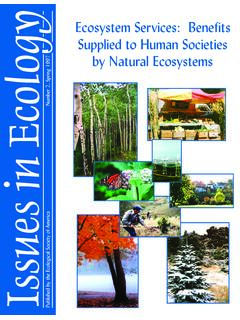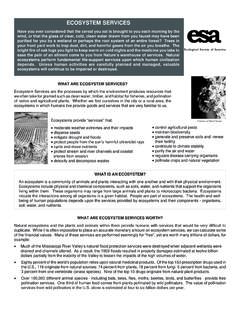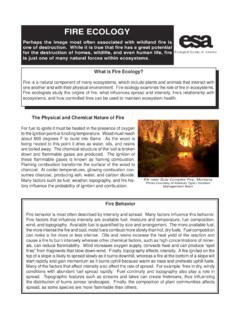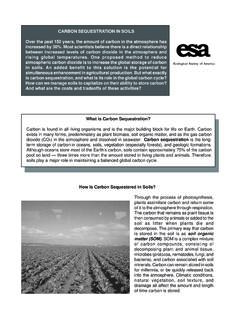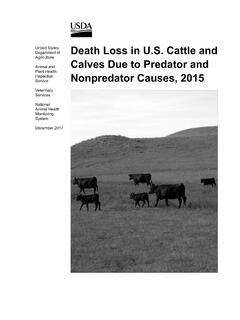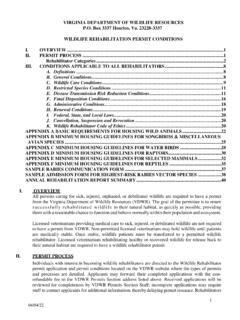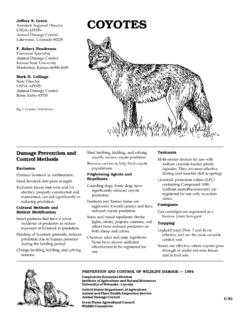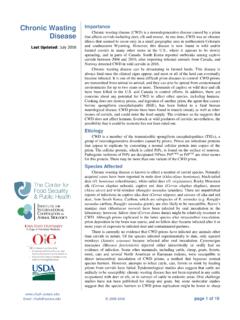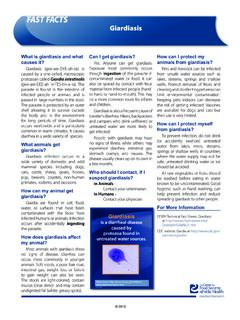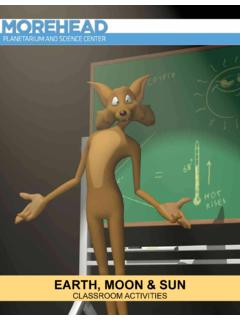Transcription of biodiversity - ESA
1 Terms biodiversity . biodiversity : The range of variation found among microorganisms, The concept of biodiversity has provoked considerable debate and plants, fungi, and animals. Also the richness of misunderstanding among the general public, decision-makers, and even species of living organisms. the scientific community. Much has been published on the subject since its first appearance at the National Forum on biodiversity in September, Ecological Society of America Community: Populations of organisms of different species that interact with one another. 1986, the proceedings of which became the best-seller, biodiversity . But what is biodiversity , what threatens it, why is it important, and what are Ecosystem: Any geographic area with all of the living organisms ecologists doing to better understand it?
2 Present and the nonliving parts of their physical environment. Involves the movement and storage of What is biodiversity ? energy and matter through living things and activities. Short for biological diversity, biodiversity includes all organisms, species, and populations; the genetic Gene: A unit of inherited material. An organism's collection variation among these; and all their complex assemblages of communities and ecosystems. It also of genes determines what it is, what it looks like, refers to the interrelatedness of genes, species, and ecosystems and their interactions with the and often how it behaves. environment. Usually three levels of biodiversity are discussed genetic, species, and ecosystem diversity. Organism: An individual living thing. Genetic diversity is all the different genes contained in all individual Population: A group of individuals belonging to one species living plants, animals, fungi, and microorganisms.
3 It occurs within a species as in an area. well as between species. Species diversity is all the differences within and between populations Species: A group of populations of similar organisms that of species, as well as between different species. reproduce among themselves, but do not naturally reproduce with any other kinds of organisms ( , Ecosystem diversity is all the different habitats, biological communities, Haliaeetus leucocephalus--bald eagle; Quercus and ecological processes, as well as variation within individual ecosystems. rubra--red oak tree). What are the Threats to biodiversity ? The loss of biodiversity is a significant issue for scientists and policy-makers and the topic is finding its way Where Can I Get More Information? into living rooms and classrooms.
4 Species are becoming extinct at the fastest rate known in geological history and most of these extinctions have been tied to human activity. Ecological Society of America, 1707 H Street, NW, Suite 400, Washington, DC 20006. 202-833-8773. Habitat loss and destruction, usually as a direct result of human activity and population growth, is a major force in the loss of species, populations, and ecosystems. Geological Survey, Biological Resources Division. Alterations in ecosystem composition, such as the loss or decline of a species, can lead to a loss of biodiversity . For example, efforts to eliminate coyotes in the canyons of southern California are linked to Fish and Wildlife Service. decreases in song bird populations in the area. As coyote populations were reduced, the populations of their prey, primarily raccoons, increased.
5 Since raccoons eat bird eggs, fewer coyotes led to more Marine Conservation Biology Institute, 15805 NE 47th Court, Redmond, WA 98052. 425- raccoons eating more eggs, resulting in fewer song birds. 883-8914. The introduction of exotic (non-native) species can disrupt entire Convention on Biological Diversity, Secretariat, 393, Saint Jacques Street, Suite 300, Montreal, ecosystems and impact populations of native plants or animals. These invaders Quebec, Canada H2Y 1N9. 1-514-288-2220. can adversely affect native species by eating them, infecting them, competing with them, or mating with them. National Forum on biodiversity . 1988. biodiversity . Wilson, , editor. National Academy of Sciences. Academy Press, Washington The over-exploitation (over-hunting, over-fishing, or over-collecting) of a species or population can lead to its demise.
6 Human-generated pollution and contamination can affect all levels of biodiversity . Prepared by the Ecological Society of America 1707 H Street, NW, Suite 400, Washington, DC 20006 Global climate change can alter environmental conditions. Species and phone 202-833-8773 fax 202-833-8775 populations may be lost if they are unable to adapt to new conditions or relocate. Fall 1997 courtesy NC Division of Marine Fisheries Why is biodiversity Important? The diversity of life enriches the quality of our lives in ways that are not easy to quantify. biodiversity is biodiversity also supplies indirect services to humans which are often taken for granted. intrinsically valuable and is important for our emotional, psychological, and spiritual well-being. Some consider These include drinkable water, clean air, and fertile soils.
7 The loss of populations, that it is an important human responsibility to be stewards for the rest of the world's living organisms. species, or groups of species from an ecosystem can upset its normal function and disrupt these ecological services. Recent declines in honeybee populations may Diversity breeds diversity. Having a diverse array of living organisms allows other organisms to take advantage result in a loss of pollination services for fruit crops and flowers of the resources provided. For example, trees provide habitat and nutrients for birds, insects, other plants and animals, fungi, and microbes. biodiversity provides medical models for research into solving human health problems. For example, researchers are looking at how seals, whales, and penguins use oxygen Humans have always depended on the Earth's biodiversity for food, shelter, and health.
8 Biological resources during deep-water dives for clues to treat people who suffer strokes, shock, and lung that provide goods for human use include: disease. food species that are hunted, fished, and gathered, The Earth's biodiversity contributes to the productivity of natural and agricultural as well as those cultivated for agriculture, forestry, systems. Insects, bats, birds, and other animals serve as pollinators. Parasites and aquaculture; and predators can act as natural pest controls. Various organisms are responsible shelter and warmth timber and other forest for recycling organic materials and maintaining the productivity of soil. products and fibers such as wool and cotton; Genetic diversity is also important in terms of evolution. The loss of individuals, medicines both traditional medicines and those populations, and species decreases the variety of genes the material needed synthesized from biological resources and for species and populations to adapt to changing conditions or for new species to processes.
9 Evolve. What are Ecologists Doing to Better Understand biodiversity ? Knowledge of biodiversity has increased in the last ten years, as has the realization Ecologists also play a prominent role in researching that something must be done to counteract the loss of species, populations, and the conservation, restoration, and use of biodiversity ecosystems. There is still much to be learned about biodiversity and its relationship and related ecosystem processes. Some ecologists to the functioning of our world, so scientific research and debate continues. And investigate the effects of different land uses and results are being applied to efforts to conserve biodiversity now. management practices. Restoration ecologists are developing rationale and methodologies for rehabilitating Ecologists conduct research to better understand biodiversity , quantify its loss, or restoring damaged habitats and for and develop strategies for conserving and using it.
10 Much is still unknown as to courtesy Fish and Wildlife Service reintroducing native species. Another important area of ecological research what species exist, where they occur, and the relationships between them. By is understanding the implications of global climate change for biodiversity inventorying and monitoring biodiversity , ecologists study species abundance, conservation. functions, interactions, and importance to maintaining or enhancing the quality of human life. Questions to which ecologists are seeking answers include: A new challenge for ecologists is determining the relationship between How fast and in what locations is biodiversity being lost? And why? biodiversity and ecosystem functioning. This issue was identified as one of What are the secondary consequences of those losses?
